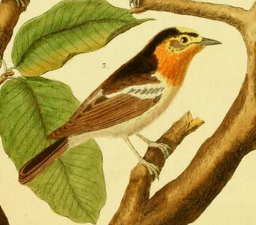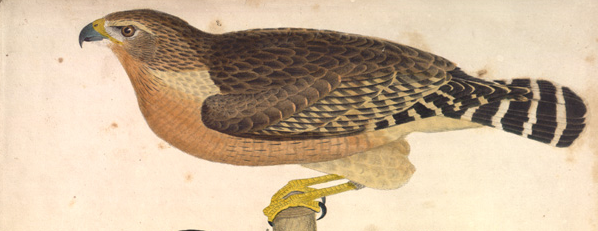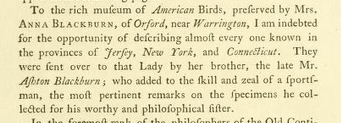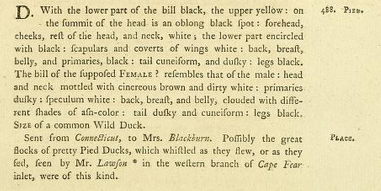Uncommon now and uncommon then, the Red-shouldered Hawk was encountered only “occasionally” by Alexander Wilson on his trips to the Jersey shore; this fierce-looking male seems to have been shot near Egg Harbor and mounted for display in Peale’s Philadelphia museum.
By the time Wilson painted and published this bird, the species had been known to European ornithology for a generation. Gmelin had named it Falco lineatus on the basis of descriptions published in the 1780s by Latham and Pennant; it was Pennant, working with a Long Island specimen from Anna Blackburne‘s collection, who gave it the English name we still use today.
So far as I know, Anna Blackburne never set foot in the New World, but her brother, Ashton Blackburne, was, in Pennant’s words, a skilled and zealous “sportsman” in New York, Connecticut, and here in New Jersey.
Ashton Blackburne, who was also first cousin to the great museum man Ashton Lever, dispatched annual shipments of American curiosities to “his worthy and philosophical sister.” According to McAtee, Blackburne, by way of his sister, provided Pennant with specimen material for no fewer than 101 of the species accounts in the Arctic Zoology; seventeen of those birds, from the Vesper Sparrow to the Labrador Duck, were new to science.
It is one of the mild ironies of ornithological history that the only one of those 101 species to bear the English name “Blackburnian” — a name assigned by both Pennant and Latham, codified by Gmelin as blackburniae, and retained in its latinized form by systematic ornithology for more than a century — well, that species wasn’t really new, and it already had a correctly formed and properly published Linnaean label.
In 1776, the incomparably well named Philipp Ludwig Statius Müller took Buffon’s “figuier orangé,” named for the “belle couleur orangée” of its throat, and restyled it in Latin Motacilla fusca, a dull name that highlights instead the bird’s brownish upperparts. Regardless, we’re stuck with it, and we know the bird today as Setophaga fusca (and yes, my fingers very nearly typed a different genus name, starting with a D).

My modest proposal: Let’s make up for it. I doubt that we’ll readily abandon such nicely established names as Red-shouldered Hawk and Dickcissel, but there is one of Pennant’s nova that may soon be in search of a better English name.
The Willet was described by Pennant from a New York specimen in Mrs. Blackburn’s collection. Now that the birds of the coast and the birds of the prairies are widely considered specifically distinct, why not call our eastern bird the Blackburnian Willet? I like it.
A lot.





